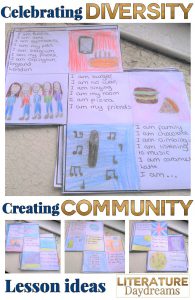Category Archives for "Community"

I don’t know about you but I love Christmas. I love Christmas, like I love Shakespeare.
It’s a deep abiding love. The run-up to the holidays here in London is full of little traditions – today is Stir Up Sunday (which I have failed to do and so am behind already!), next week we have our Christmas Give Back collections at school, the Christmas concert, carol service, secret Santa. You name it, we do it.
And yet…every year the teens in my classroom moan and complain about everything Christmas (except the snacks). They love to hate it. They hate the music, they hate the decorations, the Christmas jumpers, buying presents, being nice. Scrooges and Grinches the lot of them. So each year I do 2 activities to combat these Scrooges of ELA.
No.1 color a card for someone at school and
No.2 write your own Christmas card poem.
These cards are super cool, the slick, modern designs appeal to our London teens. They aren’t interested in Christmas cottages or cuddly Santas. They want something modern, not traditional.

*I send emails with teaching tips, tricks, and free resources to my subscribers regularly. I value your privacy and you can learn more about how I handle your data in our private policy. You can unsubscribe at any time.
Revision is a tricky nut to crack, especially for literature students where the topics for revision are as wide ranging as quotations from the text to feminist readings to historical context.
Jenga Revision is just one of the ways I help student memorise everything they need to know.
1. Get hold of your Jenga blocks (you will need felt tips as well)
The cheapest Jenga blocks I have found are these mini Topple Towers from Poundland. Just £1 each. The tower doesn’t stand much higher than 15cm. But that makes it perfect for small group work.
*Note – buy the cheapest ones you can – because these will be unfinished wood and easier to write on with felt tip!*
2. Decide what you are going to write on them.
When I started out using this activity, I was totally laid back about what went on the blocks. A few years on and I’m a little wiser. Here’s what I learnt:
Colour code the categories – so red for direct evidence from the text, blue for historical context, green for key literary terms.
Get students to plan / find the information first – no writing on the blocks until you’ve written it on paper (this can help avoid lots of repetition too)
Brevity rules! The blocks can only take 1 or 2 words – so precision is needed.
Neatly does it – some of those boys need to earn the right to write. Prove to me you can be legible, gentleman!
3. Get working on making the blocks. Depending on the number of texts to be revised, I will either allocate each group a different text or split the chapters or sections across a number of groups.
4. Get your game on. Here are the rules of the game.
# Choose who goes first (tallest, shortest – I don’t mind).
# Person number 1 pulls out a block and uses the information on it to ask a question of someone else in the group. For example – say the block has the name “Crooks” on it. The questioner could form any question that will give them the response Crooks. The harder the question, the better. Which character in Of Mice and Men has their own chapter? Who does Curley’s Wife threaten to string up? Which character in the novel reads a lot?
# If the response is correct, then the responder is given that block to start making their collection. They then take the next turn.
# If the response is incorrect, then the questioner keeps it (for their collection). And they keep taking turns and keeping blocks until someone answers correctly.
# The winner is the one who has the most blocks when the tower is completely gone. This encourages them to make the questions as difficult as possible.
And that my friends is how we play revision Jenga!
Thanks for reading.
The first few hours or days back at school are hectic. Timetables to give out, courses to enrol, books to organise. Annndd in my case – uniforms to check, planners to sign, and inevitability parents to call about incorrect shoes, hair, make-up, skirt length, nail varnish. We are busy: sorting out seating plans, handing out new books, sorting out target sheets and stickers, homework schedules, IEPs and TA resources.
Yup – back to school is hectic.
Added to this, most schools encourage a full-pelt return to hard learning. “What the learning question for your first lesson?”
Sometimes we just need a little bit of time.
For my new classes with older students – I like to gain 10 minutes or so with a few easy ‘get to know you’ activities.
Espresso Yourself – does that just that. Buys me 10 minutes to calm, followed by quality chat with the kids I have only just met. While I am muddling through the register and seating plan, they are telling me everything I need to know about them.

*I send emails with teaching tips, tricks, and free resources to my subscribers regularly. I value your privacy and you can learn more about how I handle your data in our private policy. You can unsubscribe at any time.

*I send emails with teaching tips, tricks, and free resources to my subscribers regularly. I value your privacy and you can learn more about how I handle your data in our private policy. You can unsubscribe at any time.
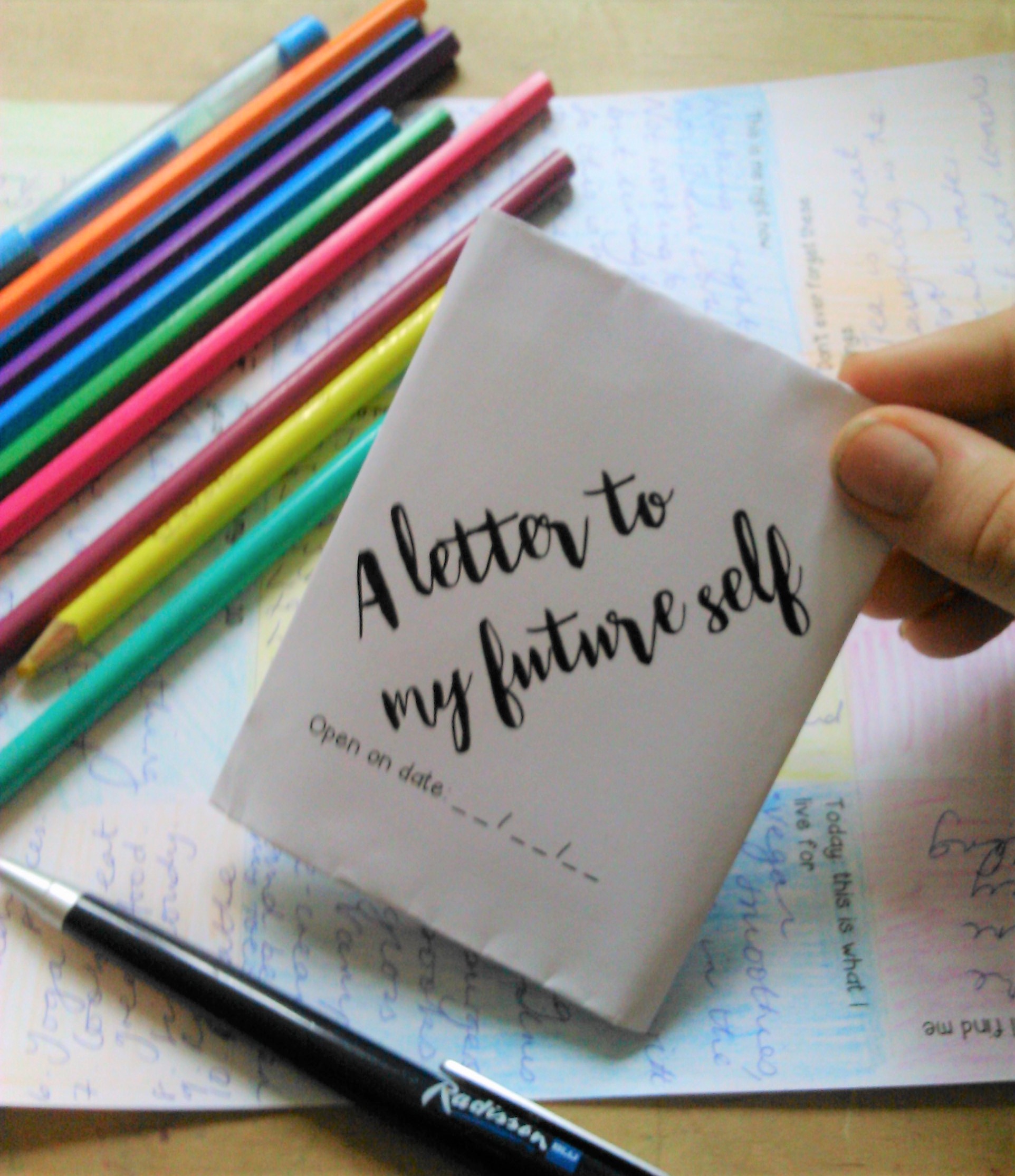
As the new school year approaches, I get a feeling – the same feeling I get every year – nervous and excited. I know that I will be meeting a bunch of new students: some I’ve never taught before, and some returning faces.
For each of these kids, I make a silent promise each September, that I will really see them. That I will take the time to get to know them. That they won’t fade into the background. That even though I will only see them 3 times a week (sometimes less) that they will be known in my classroom.
So I do all the usual stuff: learning names, memorising faces, greeting at the door.
Yet, it isn’t our classroom chat that helps me find out who these kids really are. It helps for sure. But there is something I do with my students that, every year, blows my mind without fail. It is to have them write me a letter. In fact to have them write me lots and lots of letters. A letter, a week for the first full term of school. That’s 13 letters, 13 chances for them to tell me the stuff that matters.
I love letter writing. It’s been ages since I’ve received anything more personal than a greetings card in the post. When I receive a letter, well, that’s something special. I like to tell kids about how when I left home, there were no mobile phones, no email or FB. I mean it was the 1990s, man! If we wanted to keep in contact with friends, who had moved to another part of the country, we had to write a letter. I moved to London. My best friend moved about 400 miles away to the Scottish borders. We would write to each other once a month – sometimes 10 sides of paper or more – I loved receiving those letters.
![]()
Letter writing, like diary writing, has been replaced by 140 characters or a fuzzy selfie. As letters are by their very nature personal – when we lose them, we risk losing a deep knowledge of human nature. Today we can watch fast-moving news events live. But what about the people involved a week later or a year later? Letters allow us time to reflect on our circumstances. If ever a species was in need of a pause button, it is humanity.
The first letter that my students write – is a letter to their future selves. Meh. You might say. Been there, done that. Well, this letter is something a little different. Perhaps because it isn’t a letter at all. I like to ease my students into the idea of writing me a few pages. It’s more a series of thoughts, or reflections, a collection of hopes and dreams.
We write this first letter in class. Students color in the different sections and then hilarity follows as I show them the complicated way to fold it up to make a ‘Renaissance folded letter’. I explain that paper and postage were very expensive in the 1600s-1700s. Envelopes would have been a huge waste. So people learned to write on every available space, except for the space with the address and the wax seal.
This moment has another purpose. We learn to laugh together. We learn to fail together. We become a team in this lesson.
After this first lesson, I set my students a letter-writing homework each week through September, October, November, and December. We have a few mini-sessions on the “Lost Art of Letter Writing” (start with a greeting etc) but other than that, this is one of the rare times my students get to do writing without overly structured input.
They do have a rubric, but I have to be hands-up-honest here and say, I don’t always mark their letters for grammar and spelling and stuff like that. I find myself thanking students for sharing something, more often than not I find myself asking questions, wanting to know more. At this point for me, these are more than marks on the grade sheet. And my kids need to know that.
There is no topic I won’t set, and depending on the age group of my class, we have covered them all. From ‘what is love’ to ‘my best day out’. From ‘is Britain a dystopia?’ to ‘is free speech really a good thing?’. Students know the letters that are set for them to think through a particular topic. To express their beliefs, opinions, and whatever muddle comes in between. Many times a student will start out with “I believe…” and by the end, they have found some different thoughts.
While I am being honest, I also what to tell you about the unexpected and awesome benefits of these letters. These were totally unplanned by me when I was developing this idea. First off, my students are more confident to express their ideas and opinions in my classroom. Yay! Less tumble-weed and more “I’m waiting for quiet!” but in an ELA classroom debate, discussion, and ideas are at the heart of what we do. Second, I discovered these kids are funny and clever and may does that give me hope for the future. (This one probably should have been first up). Last but by no way least, my students are better writers. And that’s my day job. These letters push them to think on topics they don’t really think about and they are improving in their writing and their expression for it.
So my advice – get your students writing letters. If you are interested in using this idea in your classroom. Click the image below.
Schools are wonderfully diverse communities. In fact, when I remember my ‘other’ job in the real world, I see what a bubble I existed in for such a long time. Working away, like a hamster on a wheel, with people doing jobs like me, who were pretty much, just like me.
I don’t have a choice who rocks up at my classroom door. Even teaching in a school with a very small catchment area, I see the full and wide range of human experience reflected in the kids I teach.
This year, more than any before, I have wanted to champion both diversity and community in my ELA classroom. To give space for challenge and difference and to enjoy togetherness and unity. An idea for this – linked to writing – segued from a unit we were already studying. In Year 7 / Grade 7 we analyze a series of poems from different cultures, if you never heard or seen them I would recommend the following: Blessing by Imtiaz Dharker and Night of the Scorpion by Nissim Ekeziel.
I wanted my students to have the opportunity to give voice to their culture, just as these poets had. But in teasing out these thoughts, I quickly realised that even within one class of 30 students, we had no fixed culture. Yes we live in the same town, but some of us speak different languages at home, eat different food, love different music. I needed to find a way to hold both our difference and our unity up for the world to admire.
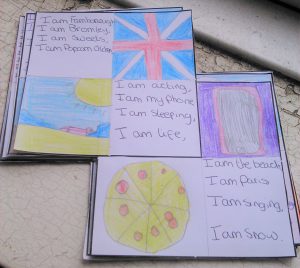
It could not have been any more simple in the end, the “I am” poem allowed my students to express both at once, in a muddle and a mix, just as it is.
Here’s what I asked students to do:
Once everyone had ideas in each box, we then discussed how to chose the ones that best represent ‘me’. I didn’t want to tell kids that ‘my iphone’ was wrong because that would have gone wholly against what I was aiming for – a celebration of them.
After the list generation phase, I would show the class my responses. Below is my original list (occasionally, now, I edit it and add sky diving or lion taming, just for fun).
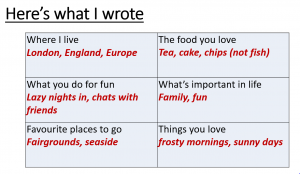
Then I model turning this list- in-a-box into a list poem. Firstly, we discuss nouns and articles and how in poetry missing them out can create meaning “I am tea and cake”, but occasionally they will be required because it just doesn’t sound right: “I am iPhone” becomes “my iPhone”. Again we discussed why “I am a sunny day” requires the article but “I am frosty mornings” doesn’t – looking at pluralisation and its impact.
Here’s my poem – which, yes, I show kids before they write their own one. I often ask students to consider what can be inferred from the various lines. My students tend to jump on “England and Europe” – I leave them to their speculations and then let them write their own.
I have no rules about the drafting and refining of these poems. I wanted a truthful expression. So after a lesson pottering about with words, we left the poems to ruminate for a while. Coming back to them the following day, allowed us one more opportunity to finesse and then we got creative.
I gave students this worksheet (click to download) and showed them the plan was to create a hanging squared poem to display.
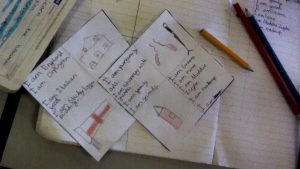
So they need to:
The result? A poem that shows the individual and yet celebrates the things that bring us together (cake, football, chicken) and the things that make us different (Russian, cheerleading champion, pro-golfer). I love it and I love them in all their samey-difference.
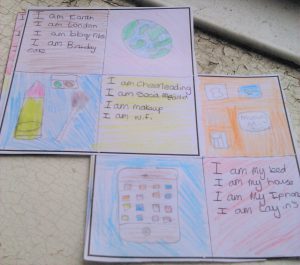
We laminate them and hang them around the room, sometimes stringing several together and leaving them to flutter in the breeze. Words and colour mixed together reminding us that diversity and community are beautiful.
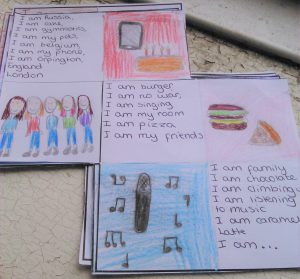 Sign up for my newsletter and receive regular updates, access to my free library and exclusive offers.
Sign up for my newsletter and receive regular updates, access to my free library and exclusive offers.

*I send emails with teaching tips, tricks, and free resources to my subscribers regularly. I value your privacy and you can learn more about how I handle your data in our private policy. You can unsubscribe at any time.
